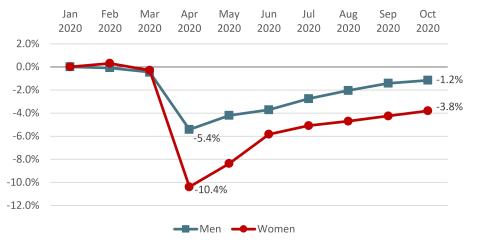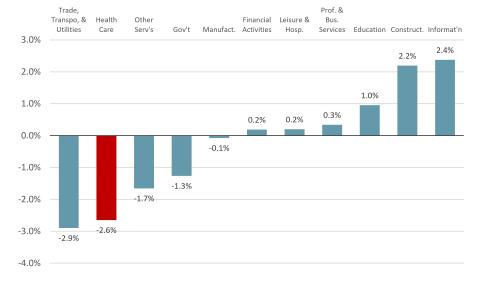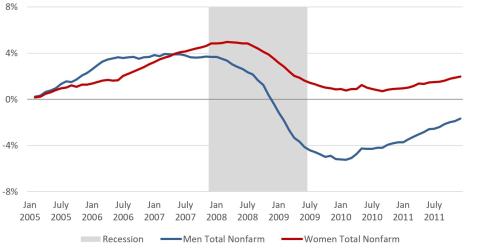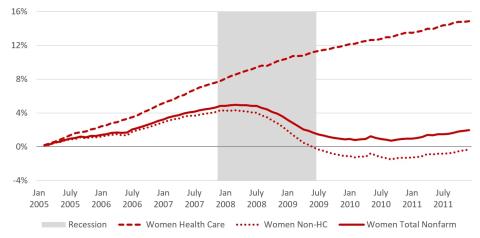
Health Sector Job Recovery Remains Slower Among Women
- Health sector job losses for women during the COVID-19 recession were greater than for men and appear to be recovering more slowly. This disparity is seen across all major health care settings.
- The job losses during this pandemic look very different from the previous recession: health care is leading much of the employment loss in 2020 and women are bearing a greater burden.
- The lack of affordable and safe childcare options during the pandemic is likely a contributor to women’s health sector job losses, as is the mix of health occupations typically held by women.
- To prevent permanent economic harms, the disproportionate and severe impacts on women’s employment during the pandemic should be met with strong and sustained policy responses supporting affordable childcare, unemployment and low-income family assistance, paid family leave, and worker education and training.
A major surprise of the COVID-19 economic crisis has been the extent of the job loss occurring in the health care sector. While the sector has typically been immune to significant employment loss during recessions, this economic crisis has impacted health care workers very differently. Despite a global pandemic that might have been expected to increase the need for health care, we have seen decreased use of discretionary and elective care (as well general concerns around the use of in-person services) cause unprecedented health care spending and employment declines in 2020. As of October 2020, neither health care spending nor employment have fully recovered to pre-pandemic levels. As we have previously reported, job losses have been asymmetric among different categories of health care workers, with outpatient settings (particularly offices of physicians and offices of dentists) bearing the greatest burden of job losses early in the pandemic, and more recently, with nursing and residential care facilities continuing to accumulate losses.
Figure 1: Percentage Change in Health Care Jobs Since January 2020, by Sex

In this brief, we focus on a notable aspect of the pandemic’s impact on health sector employment: the disproportionate job losses for women that have persisted through the recovery to date. Health sector jobs are predominantly held by women (about 13.1 of the total 16.5 million health care workers at the start of the pandemic), but even as a percentage of jobs, the extent of women’s job losses were both greater initially and remain more severe (Figure 1). Health sector employment among women initially declined by more than 10%, compared to less than 6% among men. At the lowest point in employment in April 2020, women had lost 1.4 million health sector jobs, compared to just 180,000 jobs lost for men. Further, while the pace of recovery for women between April and June closed the gender job loss gap somewhat, progress has since slowed. In the four months between July and October, a difference has persisted between male and female employment recoveries, resulting in a remaining gap of about 36,000 jobs for men to return to February levels, compared to a whopping 530,000 jobs still missing for women.
The gender gap in health care job loss exists in all major health care settings (Figure 2). While men’s jobs have either completely or nearly recovered in all settings except hospitals and nursing and residential care facilities, significant gaps persist for women: 200,000 jobs remain lost in nursing and residential care facilities, about 100,000 jobs in both hospital and other ambulatory settings, and over 50,000 in each of home health and offices of physicians. Since the April bottom of the labor market, the pace of the recovery for women’s jobs has been highest in offices of physicians and in outpatient care center settings, while nursing homes have seen a continued decline (data not shown). The continuing decline in jobs at nursing homes is particularly concerning given this setting has the greatest number of women’s jobs lost. Among nursing homes and residential care, drivers of job loss have included a decrease in elective surgeries leading to a decrease in subsequent rehabilitation needs, an unfortunate concentration of COVID-19 deaths among residents, and an increase in the use of in-home alternatives to residential care settings.
Figure 2: COVID-19 Recession Job Losses Remaining by Setting, October 2020

Across the entire US economy, we see that the disproportionate impact of the COVID-19 recession on women’s employment is not unique to health care. As a percent of total employment in January, women’s total nonfarm employment remains 7.0% lower, while men’s nonfarm employment is slightly better, just 5.9% below the total. Disproportionate impacts on women’s employment have also been seen in unemployment and labor force participation rates across the US. Early in the pandemic, women’s labor force participation rate fell more steeply (3.5 percentage points versus 3.2 percentage points) and the peak unemployment rate among women was higher (16.2% versus 13.5%).
During the period from February to October, among the major supersectors tracked by the Bureau of Labor Statistics (BLS), women lost a greater percentage of jobs in Trade, Transportation and Utilities; Health Care; Other Services; Government; and Manufacturing (Figure 3). Conversely, men have lost a greater percentage of jobs in sectors such as Construction; Information; Education; and Professional and Business Services. Directly comparing the percentage job losses between men and women, health care has the second greatest difference in jobs lost for women vs. men, second only to trade, transportation, and utilities. In absolute terms, health care is the sector with the greatest difference in the number of jobs yet to be regained between women and men (a recovery gap of greater than 500,000 jobs), resulting from the large proportion of health sector jobs previously held by women.
Figure 3: Difference in Percentage of Jobs Lost for Women and Men (Feb to Oct), by Supersector
(Negative values indicate women’s job losses are more severe)

Of note is the stark difference in health sector employment during this 2020 pandemic-driven recession compared to 2008-2009 recession following the financial crisis. In the prior recession, the pattern of growth in health and non-health employment diverged—we saw large declines in non-health jobs, but continued job growth in the health sector. As a result, hiring within the health sector (and particularly women’s jobs in health) provided a major cushion to the US labor market and overall economic downturn. Comparing the impacts of the 2008-2009 recession on men’s and women’s employment, we see that women’s employment declined more moderately and recovered faster than men’s (Figure 4). Women’s employment in the health sector persisted straight through the recession and was a major contributor to the relative strength in women’s overall nonfarm employment (Figure 5). Unfortunately, the ability of the health sector to cushion broader economic losses (and particularly losses for women) has not extended to the COVID-19 recession. In fact, this time around, health care jobs and women’s employment have been two of the categories hit hardest to date.
Figure 4: Employment Change During the 2008-2009 Recession, by Sex
(Shaded region indicates time of official recession period)

Figure 5: Women’s Employment Change During the 2008-2009 Recession, by Industry
(Shaded region indicates time of official recession period)

Experts have posited a variety of reasons for women’s job loss disparity. One cause specific to the health sector is the mix of occupations held by women at the start of the pandemic. While BLS’ monthly job statistics do not report employment by sector and occupation, we can look to prior data on men’s and women’s health care occupations from 2019 in the American Community Survey. In 2019, the health care occupations with greatest difference in numbers of women over men were Registered Nurses, Nursing Assistants, Personal Care Aides, and Medical Assistants, while the occupations with the greatest numbers of men over women were Paramedics, Dentists, Chiropractors, Surgeons, and “Other” Physicians (Figure 6). It is likely that the mix of occupation types and the types of jobs that have been eliminated by health sector employers during 2020 are factors in the disproportionate job losses among women this year. Data by occupation for 2020 won’t be available until sometime next year to confirm this hypothesis, and even those data may mask the worst of the pandemic impacts on certain occupations given their annual nature. The occupation mix is also a potential cause of the slower recovery for women’s employment, with employers prioritizing bringing back occupations that were more likely held by men this year.
Figure 6: Health Occupations with the Greatest Differences in Employed Men and Women
(2019 American Community Survey Data)

Other factors impacting women’s employment are also in play. Many experts have cited the closure of schools and childcare centers, which places a greater burden on families to care for children during the workday, as a burden that continues to fall predominantly on women. The pandemic’s closure of out-of-home childcare options in many states has forced families to make difficult employment choices. In many cases, previously dual-income households that took advantage of childcare outside of the home have had to reduce hours or even transition to a single job during the pandemic, leaving the other parent to care for young children. Additionally, the pandemic and work-from-home trends have increased the time required to complete a variety of other household tasks that continue to fall on women disproportionately, such as chores, home cooking, and education help for kids. There are significant concerns that these pandemic changes could have permanent impacts on women’s employment and subsequent long-term economic outcomes without strong countervailing actions.
As we look towards 2021, with a light at the end of the tunnel for the pandemic via vaccines, there remains a significant role for public policy to foster a return to normal for the US economy and labor market. As of November, 10.7 million people remain out of work and many industries are likely permanently altered by the prolonged impacts of this pandemic and recession. For policymakers, first and foremost there needs to be a continued focus on fighting the spread of the coronavirus. This includes public health measures such as testing, tracing, masks, and social distancing; prudent closures of high-risk environments; and the promotion, distribution, and provision of vaccines. All of these public health actions will benefit the economy over the long-term by increasing the speed at which normal economic activity can resume, including in particularly hard hit sectors such as travel, dining, and discretionary health care. Additionally, continued support for the health sector must continue to maintain capacity, including support for struggling rural providers and nursing homes. These providers face both rising costs and decreased revenues due to the pandemic and will not be able to fully recover until the spread of the virus is stopped.
Specific to the greater burden this pandemic has caused on women’s employment in both health and non-health sectors, policymakers must focus on responses that increase the access and affordability of reliable childcare. This includes opening schools (particularly for younger children where the risk of spread remains low), additional funding for childcare, paid family leave, and also financial support for low-income families with young children. Cash benefits, whether through continued funding of emergency unemployment benefits, expanded child tax credits, or direct payments to low-income families for childcare services, have the potential to aid the overall economic recovery and provide targeted support to families in need and especially low-income women.
Lastly, policymakers should ensure long-term investments in workers are made following this pandemic so that those with extended time outside the labor force through no fault of their own do not see continued, persistent periods of unemployment. Federal investment in worker skills, retraining, affordable community college, and increasing earned income tax credits all have the potential to increase the underlying capabilities and productivity of the US labor force, fostering continued economic growth. These approaches require a long-term view of federal government spending and a commitment to the role of fiscal policy in the response to economic shocks. The speed and scope of the federal fiscal response to the pandemic early on was laudable, but sufficient supports have not been maintained as the pandemic dragged on. Longer periods of economic support and a transition to long-term investments in the labor force will be required to pull the US out of this pandemic-driven recession well positioned for growth and leadership in the global economy.
The authors would like to thank the Robert Wood Johnson Foundation for their support of this study and Altarum’s health sector tracking and research. Opinions and findings expressed herein are solely those of the report authors.